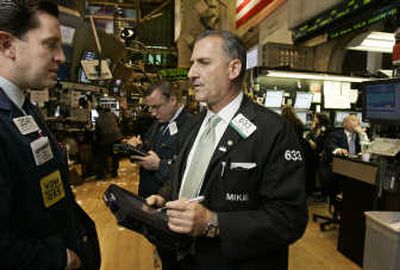Memories of a crash

NEW YORK – There were more people than computers on the floor of the New York Stock Exchange on Black Monday. Twenty years later, there are more machines – an evolution that’s still hard for some traders to accept.
Traders can point out, with an almost painful nostalgia, where they were amid the chaos of Oct. 19, 1987. They recall screaming out sell orders in front of packed trading booths as the Dow Jones industrial average began its nearly 23 percent plunge.
Since then, the NYSE has been radically changed by modernization. Traders now find themselves huddled around computers that silently do the work for them, churning out thousands of trades per second.
“You can’t feel or see the trades, you don’t hear the level of the room,” said Michael Rutigliano, a longtime NYSE broker who is now director of floor trading for W.J. Bonfanti Inc. “If there was another crash on an electronic exchange, it would happen at lightning speed. It would be like getting shot between the eyes.”
Indeed, the question about how a modern exchange will be able to handle a steep drop like the one 20 years ago hangs over those that were there to witness it. Of the 1.8 billion shares traded on an average day, 90 percent are completed by computers and 10 percent by humans.
One reason why those questions exists is because of what happened just this past Feb. 27. The Dow closed down 416 points – dropping as much as 546 at one point during the session – as the NYSE’s system became backlogged when it was unable to process the large volume of trades that day.
And there is still the fear that the market could go into a freefall – with the Dow falling perhaps thousands of points in seconds.
But, as a result of the ‘87 crash, the NYSE now has what it calls curbs that slow down trading and circuit breakers that will temporary halt it. For instance, if the Dow drops 1,350 points, or 10 percent, before 2 p.m., trading would stop for an hour to give the market time to recoup.
Other markets have developed similar moves, with the Nasdaq – which trades NYSE-listed stocks – agreeing to halt its market if there is a crash.
The fact is, the markets can’t function without computers.
The NYSE’s decision to go electronic – which it calls a hybrid market because it still involves floor traders – was made for competitive reasons.
The Nasdaq Stock Market never had a trading floor, and has lured business from the Big Board because its technology allows for faster transactions.
Edward Schreier, a managing director at Deutsche Bank who was a clerk on the floor in 1987, believes the technology is progress. “Markets have evolved, and human interaction can slow things down,” he said. “In 1987, we couldn’t keep up, we couldn’t stop it – today we can.”
But traders who were on the floor in 1987 perhaps understandably believe the markets can’t function without the human element.
“1987 to me is really about human behavior,” said Frank Hatheway, the Nasdaq’s chief economist who suffered through Black Monday as an options trader at the exchange. “I’m confident in our ability to handle what people want to do on a busy trading day, even under severe financial stress.”
Jamie Selway, a managing director with White Cap Trading, said the new NYSE electronic system is “a work in progress.” He said the NYSE and Nasdaq are continually upgrading their systems for more capacity, and testing to see how much demand can pulse through their servers. The competition between both of them – and with upstart electronic platforms like BATS Trading – force the industry to develop better, faster and safer technology.
That, he said, will help exchanges survive in a high-octane environment.
But, Selway cautions to not underestimate human interaction behind a trade – from big money managers to retail investors.
“We rely on people’s incentives,” he said. “There lot’s of fear and greed in this marketplace, just like there was 20 years ago. Buyers will buy, sellers will sell. People still want to make money.”